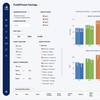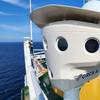Knowledge is Power
The case for independent monitoring and verification of energy-efficiency initiatives
World crude production may rise and fall, but the historical trend shows a steady increase in the price of a barrel of oil, and with it, the price of a ton of fuel. Add the demands of shareholders and charterers to increase operational efficiency and profitability, as well as increasing international pressure to reduce fuel consumption and associated greenhouse gas emissions. It is no wonder that ship owners have seen a steady rise, as well, in the availability of technologies — from ship design to propulsion and HVAC systems to hull coatings — that are purported to reduce fuel consumption.
Shipowners are interested in fuel savings technology, but they are understandably skeptical: How do they know they are achieving the fuel savings and associated payback periods? Can the ship owner or operator measure with any sense of confidence the actual savings they are able to realize from an energy efficiency investment?
Unfortunately, ship owners often do not have access to independent performance data for verification. For this reason, they expect manufacturers to provide evidence of independent third-party empirical product testing to substantiate quality, performance and regulatory compliance. When making a substantial energy efficiency investment, vessel owners and operators also expect a fundamental cost-benefit analysis of projected savings and payback.
Above and beyond requiring suppliers to provide this fundamental evidence of product quality and performance, a ship owner can only project the savings from an energy initiative and validate its performance through independent energy monitoring and verification. Moreover, they can derive the full value of this approach when an onshore team of professional marine engineers and energy analysts leverage existing ship systems to collect the data, remotely monitor and analyze trends, offer recommendations to improve existing systems, and project the costs and benefits of upgrades.
Analysis of Noon Reports, or ...
Analyzing a vessel’s noon reports for fuel consumption trends over time is a complex, time-consuming process to which most ship owners simply cannot devote the resources. However, there is a cost-effective alternative: For a minimal capital investment and monthly monitoring fee, a ship owner can contract with a third-party marine monitoring and verification service for continuous remote monitoring and analysis of real-time data from a vessel’s onboard machinery plant control and monitoring system (MPCMS).
Ideally, an energy advisory firm begins with an initial analysis of the vessel’s performance by ship system. The firm should leverage the ship’s existing metering devices and MPCMS to the extent possible, testing and validating the accuracy of measurement devices already in place, recalibrating as necessary, and installing additional metering devices as required. For example, where fuel measurement is not available on board, it is necessary to add fuel meters.
All existing and new devices should be integrated into the MPCMS so that real-time data can be pushed to the web at defined time intervals, ideally, every few minutes around the clock. The monitoring system should be built on open system standards that can be tailored to any type of vessel. The global monitoring center should itself be a secure, reliable data center, and the provider should store all operating data in the “cloud” using a secure Tier 1 collocation center. The monitoring center should be staffed with a team of degreed, licensed marine engineers and energy analysts with the requisite knowledge to analyze and interpret operating data.
The team monitors detailed ship system data, which may include main engine performance and fuel consumption including auxiliary generator performance, vessel position, fuel consumption, shaft horsepower, torque vs. revolutions per minute (RPM), and speed over ground vs. RPM. The service may also meter and monitor the ship’s HVAC system and electrical generation for hotel load. The team also integrates real-time data on weather and sea conditions into the monitoring system.
Ideally, the team should monitor the ship for a period of time to establish an operational baseline from which optimal operating parameters can be established. From this, the team can set up the monitoring system to automatically transmit alerts and alarms to ship engineers and operators when equipment and ship systems are operating outside of these parameters. Establishing a baseline also enables the advisory team to compare vessel performance before and after an energy-savings initiative, such as a performance hull coating.
Results of Real-Time Performance Monitoring
In addition to immediate alerts and alarms when systems are operating outside of optimal parameters, the provider should issue daily fuel consumption and voyage reports that enable the owner to make informed fuel purchasing decisions based on historical and forecasted operations; validate emission regulation compliance — and validate the performance of energy-efficiency initiatives.
The team can also recommend maintenance and operational adjustments to existing systems and equipment, as well as capital improvements, that will improve the overall energy efficiency of the vessel. For example, one of the key indicators of the operating condition of a diesel engine is the exhaust temperature from individual cylinders. Most commercial diesel engines have cylinder exhaust temperature indicators. Older smaller engines have analog reading thermometers while the modern larger engines typically use thermocouple pyrometers. \
A comparison of individual cylinder exhaust temperatures to one another and to the aggregate engine exhaust temperature yields many insights; therefore, monitoring of cylinder exhaust pyrometers is one of the most important diagnostic tools. Abnormal cylinder exhaust temperatures indicate many types of operating problems that increase fuel consumption, including cylinder imbalance, exhaust valve leakage, incorrect injection and/or exhaust valve timing, poor fuel atomization, low compression pressure, and turbocharger issues.
The energy advisory service should be able and willing to advise as an unbiased technical consultant to correct equipment and/or operational issues. Moreover, the service should have the capability to provide a cost-benefit analysis of potential energy-efficiency initiatives, including equipment upgrades, to enable the owner to make informed purchasing decisions.
As it is often said, “knowledge is power.” With increasing pressure for performance and energy savings from all quarters, ship owners and operators require unbiased performance analysis and insights from an onshore team of professionals to evaluate energy initiatives and optimize vessel performance under way.
Tim Angerame
is Director at utiliVisor, an energy advisory firm providing comprehensive energy monitoring and advisory services for the marine industry. Mr. Angerame is a licensed marine engineer.
t: 212-260-4800 x224
[email protected]












